Harttia is a genus of armored catfishes native to South America.
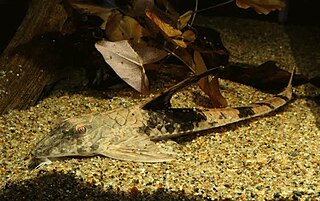
Loricaria is a genus of armored catfish native to South America.

The Hypostominae are a subfamily of catfishes of the family Loricariidae. Most members are restricted to tropical and subtropical South America, but there are also several species in southern Central America. Hypostomus plecostomus, which is popular in the aquarium trade, has been introduced to several regions far from its native range.

Pseudacanthicus is a genus of medium to large-sized suckermouth armored catfishes native to South America, where found in the Amazon and Orinoco basins, as well as rivers of the Guianas. They are primarily found in fast-flowing waters, sometimes relatively deep. They are sometimes kept in aquariums.
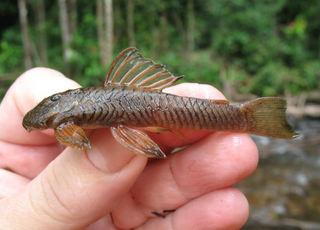
Guyanancistrus is a genus of suckermouth armored catfishes.

Guyanancistrus nassauensis is a species of catfish belonging to the family Loricariidae, the suckermouth armored catfishes. It is discovered in 2005 and formally described in 2018. G. nassauensis is a rare species, highly endemic to the Nassau Mountains in Suriname, and is threatened with extinction by proposed or ongoing mining activities.

The Nassau Mountains is a mountain range in the Sipaliwini District of Suriname. It is named after the House of Nassau.
Peckoltia simulata is a species of catfish in the family Loricariidae. It is native to South America, where it occurs in the Oyapock River in French Guiana. The species is typically found in small forested creeks with a substrate of gravel or sand, as well as rocks, leaves, and wood. It has been collected alongside a variety of other species, including other loricariids belonging to the genera Ancistrus, Farlowella, Guyanancistrus, Otocinclus, and Rineloricaria.
'Pseudancistrus' megacephalus is a species of catfish in the family Loricariidae. It is of uncertain and disputed classification.
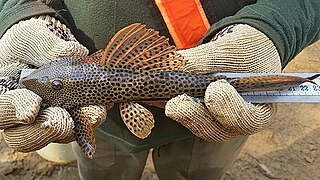
Aphanotorulus emarginatus is a species of catfish in the family Loricariidae. It is native to South America, where it occurs in the Amazon River basin. The species reaches 15 cm in total length. It is known to be a facultative air-breather.
Hypostomus gymnorhynchus is a species of catfish in the family Loricariidae. It is native to South America, where it occurs in coastal drainages of French Guiana, ranging from the Oyapock to the Maroni basin. It is a rheophilic species that occurs in shallow, sunny rapids with strong currents and rocky substrates. While the species can reach 26.6 cm in standard length, it rarely exceeds 20 cm.
Hypostomus nematopterus is a species of catfish in the family Loricariidae. It is native to South America, where it occurs in the Oyapock basin in French Guiana. The species reaches 10.7 cm (4.2 in) in standard length and is believed to be a facultative air-breather.

Guyanancistrus brownsbergensis is a species of catfish in the family Loricariidae. It is native to South America, where it occurs in the upper Kumbu Creek, which is part of the Saramacca River basin, in Brownsberg Nature Park in the Brownsberg Mountains in Suriname. The type locality of the species is a small mountain stream with a width of 2.5 to 3.7 m, a depth of 28 to 50 cm, a temperature of 23.1 to 23.2 °C, an oxygen concentration of 7.08 to 7.72 g/mL, an oxygen saturation of 93% to 96%, a pH of 7 to 7.5, a conductivity of 30.8 to 31.6 μS/cm, and a current strength of 0.29 to 0.56 m/s. The stream has clear water and a substrate composed of sand, gravel, pebbles, bedrock, and boulders, and overhanging vegetation, leaf litter, and woody debris are present. The species reaches 6.4 cm in standard length. It is known that the habitat of the species is threatened by illegal gold mining.
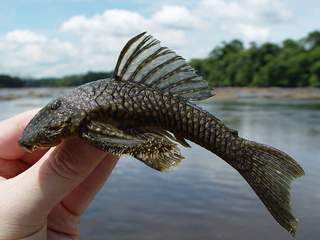
Guyanancistrus longispinis is a species of catfish in the family Loricariidae that is of disputed classification. It is native to South America, where it occurs in the Oyapock basin in French Guiana. It is typically seen in shallow rapids with rocky substrates and moderate levels of illumination. It is known to occur alongside the species Guyanancistrus brevispinis, Harttia fowleri, and Crenicichla ternetzi, as well as members of the genus Ancistrus. The species reaches 10.4 cm in standard length and may be a facultative air-breather.
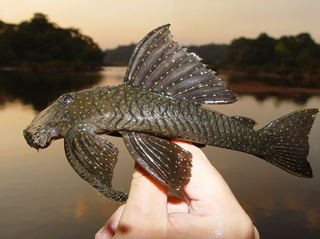
Guyanancistrus niger is a species of catfish in the family Loricariidae that is of disputed classification. It is native to South America, where it occurs in the Oyapock basin in French Guiana. Though reportedly uncommon, it is typically seen in rapids where the species Pseudancistrus barbatus is also present, although the ecological relationship between the two is not known. The species reaches 15.9 cm in standard length, although it has been reported to reach 25.4 cm, and it may be a facultative air-breather.

Guyanancistrus tenuis is a species of catfish in the family Loricariidae. It is native to South America, where it occurs in a forested tributary of the Mapaoni River in the upper Jari River basin in French Guiana, near the Mitaraka Massif, which is a prominent massif in the area. The environment in which the species is typically found is a shallow mountain creek with medium to strong currents, a depth of 20 to 60 cm, and some pools. The species reaches 9.1 cm in standard length. Its specific epithet, tenuis, is derived from Latin and refers to its slender body.
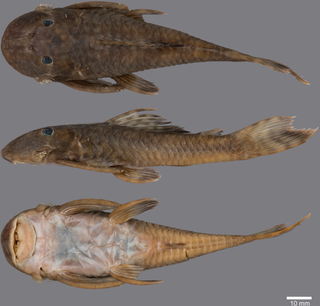
Guyanancistrus teretirostris is a species of catfish in the family Loricariidae. It is a freshwater fish native to South America, where it occurs in the upper Paru de Oeste River in Brazil. The species reaches 9.8 cm in standard length. Its specific epithet, teretirostris, is derived from Latin and refers to the rounded shape of the species' snout.

Cryptancistrus similis is a species of catfish in the family Loricariidae and the only member of the monotypic genus Cryptancistrus. It is a freshwater fish native to South America, where it occurs in the upper Paru de Oeste River in Brazil. The species reaches 6.2 cm in standard length. It was described in 2018 by Sonia Fisch-Muller, Jan Mol, and Raphael Covain as part of a taxonomic review of the genus Guyanancistrus, which Cryptancistrus was found to be distinct from but closely related to. Its specific epithet, similis, is derived from Latin and references the species' similarity to the species of Guyanancistrus, specifically Guyanancistrus brevispinis.
Loricaria cuffyi is a species of catfish in the family Loricariidae. It is native to South America, where it occurs in the Essequibo River and Rio Negro basins in Guyana, as well as the Orinoco basin in Venezuela, with its type locality being designated as the Ireng River. The species was described on the basis of 36 specimens in 2020 by Alejandro Londoño-Burbano, Alexander Urbano-Bonilla, and Matthew R. Thomas. FishBase does not yet list this species.
Harttiella longicauda is a species of catfish in the family Loricariidae. It is native to South America, where it occurs in mountainous areas in the vicinity of Trinité Massif and Balenfois Massif in northern French Guiana. The species reaches 5.2 cm in standard length. It is known to occur alongside the species Characidium fasciadorsale, Krobia itanyi, Lithoxus planquettei, and Rhamdia quelen, as well as members of the genera Ancistrus, Guyanancistrus, Melanocharacidium, and Rineloricaria. The species was described in 2012 as part of a taxonomic review of members of the loricariid tribe Harttiini native to the Guianas.













